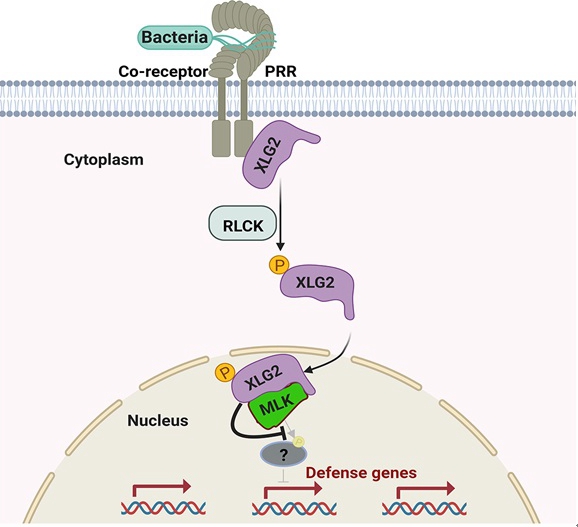Plant cell-surface localized immune receptors recognize conserved microbial features to perceive pathogen invasion and activate plant immunity. Heterotrimeric G proteins, which are composed of α, β and γ subunits, are widely found in eukaryotes and play important regulatory roles in eukaryotic cells.
Previous studies by a research team led by Prof. ZHOU Jian-Min from the Institute of Genetics and Developmental Biology (IGDB) of the Chinese Academy of Sciences (CAS) have shown that plant-specific Gα protein XLG2 regulates plant immunity by directly coupling to immune receptors. Upon pathogen infection, XLG2 was phosphorylated by the central immune kinase RLCKs at the N terminus. However, how XLG2 regulates immune receptor-mediated downstream immune signaling remains unknown.
The research team led by Prof. ZHOU published a new study in the Cell Host & Microbe on Oct. 13 (doi.org/10.1016/j.chom.2022.09.012). In this study, the researchers found that microbial patterns rapidly induce the nuclear accumulation of XLG2, which requires its nuclear-localization signal (NLS) motif and phosphorylation sites of XLG2. They showed that the nuclear localization of XLG2 plays an important role in plant resistance to bacterial pathogens.
The researchers further identified that nuclear-localized XLG2 interacts with a family of kinase named Mut9-like kinases (MLKs). While MLKs negatively regulate defense gene expression in a kinase activity dependent manner, XLG2 de-represses immune response by inhibiting the kinase activity of MLK, and probably suppresses its phosphorylation on downstream unknown targets.
This study reveals a new pathway that linking surface-localized immune receptors and defense gene expression in the nucleus, which might provide new clues for improvement of plant resistance. Meanwhile, this finding also greatly improved our understanding on heterotrimeric G protein-mediated downstream signaling in plants.
A model illustrating nuclear-localized XLG2 coordinated plant defensed gene expression with MLKs. (Image by IGDB)
Contact:
Prof. ZHOU Jian-Min
Institute of Genetics and Developmental Biology, Chinese Academy of Sciences
 A model illustrating nuclear-localized XLG2 coordinated plant defensed gene expression with MLKs. (Image by IGDB)Contact:Prof. ZHOU Jian-MinInstitute of Genetics and Developmental Biology, Chinese Academy of SciencesEmail: jmzhou@genetics.ac.cn
A model illustrating nuclear-localized XLG2 coordinated plant defensed gene expression with MLKs. (Image by IGDB)Contact:Prof. ZHOU Jian-MinInstitute of Genetics and Developmental Biology, Chinese Academy of SciencesEmail: jmzhou@genetics.ac.cn CAS
CAS
 中文
中文




.png)
